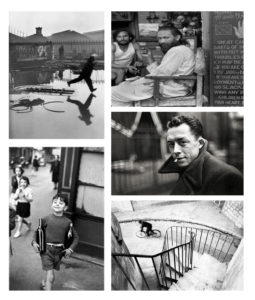Henri Cartier-Bresson born August 22, 1908, died August 3, 2004, was a French humanist photographer considered a master of candid photography, and an early user of 35 mm film. He pioneered the genre of street photography, and viewed photography as capturing a decisive moment. His work has influenced many photographers. In 1952, Cartier-Bresson published his book The Decisive Moment. It included a portfolio of 126 of his photos from the East and the West.
In early 1947, Cartier-Bresson, with Robert Capa, David Seymour, William Vandivert and George Rodger founded Magnum Photos. Capa's brainchild, Magnum was a cooperative picture agency owned by its members. The team split photo assignments among the members. Cartier-Bresson would be assigned to India and China. Maria Eisner managed the Paris office and Rita Vandivert, Vandivert's wife, managed the New York office and became Magnum's first president. Cartier-Bresson achieved international recognition for his coverage of Gandhi's funeral in India in 1948 and the last stage of the Chinese Civil War in 1949. He covered the last six months of the Kuomintang administration and the first six months of the Maoist People's Republic. He also photographed the last surviving Imperial eunuchs in Beijing, as the city was falling to the communists. In Shanghai, he often worked in the company of photojournalist Sam Tata, whom Cartier-Bresson had previously befriended in Bombay. From China, he went on to Dutch East Indonesia, where he documented the gaining of independence from the Dutch. In 1950, Cartier-Bresson had traveled to the South India. He had visited Tiruvannamalai, a town in the Indian State of Tamil Nadu and photographed the last moments of Ramana Maharishi, Sri Ramana Ashram and its surroundings. A few days later he also visited and photographed Sri Aurobindo, Mother and Sri Aurobindo Ashram, Pondicherry. Magnum's mission was to "feel the pulse" of the times and some of its first projects were People Live Everywhere, Youth of the World, Women of the World and The Child Generation. Magnum aimed to use photography in the service of humanity, and provided arresting, widely viewed images. Below is a link to Cartier-Bresson's page on MAGNUM Photos. http://pro.magnumphotos.com/C.aspx?VP3=CMS3&VF=MAGO31_10_VForm&ERID=24KL53ZMYN

